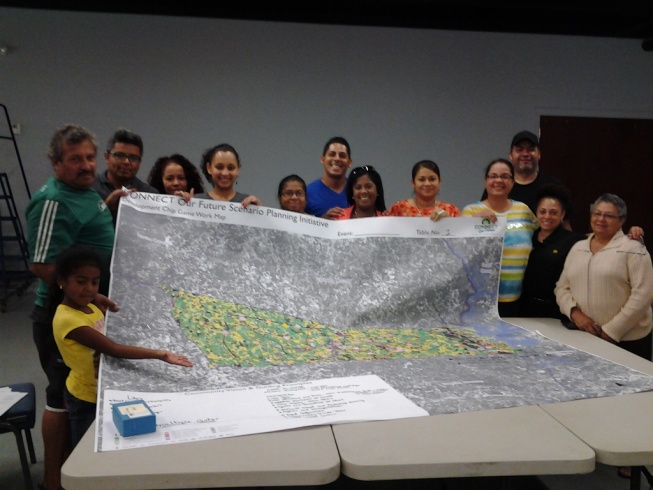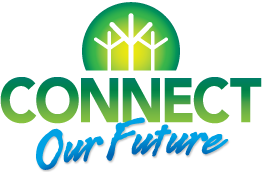Public or Civic Engagement is a critical part of planning and implementation at local, regional, state, and federal levels of government. Every major community project can benefit from an inclusive, thoughtfully designed public engagement process. Public Engagement (or PE) in this tool refers to the inclusion of a broad range of opportunities and methods for the residents of an area to provide input on and feedback regarding any type of public policy, program, or project. However, the tools can also be used by schools, non-profits, or community groups to improve decision-making and implementation results.
Why is this important to your community?
Governmental organizations at all levels have been encouraged or required to get “public input” on their proposals for years. Routinely, these public input opportunities took the form of public hearings or drop-in comment sessions at a public building, and unless the topic was ‘hot,” staff frequently outnumbered the members of the public who showed up. Those who did come tended to be better-educated, middle- to upper-income individuals who were connected to the issue, and who, in many cases, were “regulars” at public hearings and events. Their input was (and continues to be) very valuable, but with the changing demographics of the region, and the increasing percentage of persons living in poverty, it is important to expand the range of voices heard on public issues, because public issues affect all, or most, of the public.
Reaching out to groups that traditionally have not participated in public processes involves overcoming several challenges—people may not be familiar with the issues, may not have the context, and because they may not have a history of “feeling heard,” may be hesitant to participate, or may feel out of place in the process. There may also be child care, language, transportation, and timing barriers. But it is worth the effort to make the effort--doing so produces multiple benefits to the community and to the local government:
- It ensures that ALL the people likely to be impacted by policy, program, or project have an opportunity to speak to it, so that public engagement engages ALL the public and supporting truly democratic process.
- It addresses issues of equity and inclusion needed to create a true sense of community, where all persons have “a stake in the action.”
- It increases support and buy-in to the final product and its implementation, particularly when people see their comments reflected in the results.
- It improves decision-making—ensuring that potential problems and unintended impacts are not overlooked and bringing more ideas, creativity, and brainstorming into the process.
In summary, virtually every major community project can benefit from an inclusive, thoughtfully designed public engagement process.
Where is it appropriate to use?
What priorities does it address?
What other tools are related?
- Land Use Modeling
- Regional GIS Data Center
- Business and Education Training for Farmers
- Community-Based Housing Strategies
- Educating Officials about Housing Diversity
- Energy Efficient Residential Practices and Funding
- Greenways and Trails Planning
- Growth Management and Cooperation
- Healthy Food Access Portal
- Hazard Mitigation Planning and Implementation
- Local Food Councils
- Main Street Programs
- Park and Greenway Access
- Parks Promotion Campaigns
- Regional Cooperation
- Safe Routes to School
- Stormwater Best Management Practices (BMPs)
How does it work?
Strategies and tools for inclusive public engagement have come a long way since agencies were first required to conduct “public hearings in the 1970s. Tools and techniques are available for reaching all segments of the population and all demographics—young, old, people of all income levels, races, ethnicities, languages, and backgrounds. Increasingly, hands-on activities are valuable, especially in discussing future land use or transportation issues, but they may also be valuable in addressing human services questions, and they have the great benefit of overcoming literacy and language issues. The primer on the following pages provides information about some of the different techniques and approaches used by CONNECT Our Future in its very robust, inclusive, and highly-acclaimed public engagement, and lessons learned in the process.
One of the most important aspects of public engagement is making strategic decisions regarding the following:
- What are you looking for, in terms of input, and in terms of the public engagement process results?
- What do you need to share with the public in order for them to have the context and information to be able to give you what you are looking for?
- From whom do you need to hear?
- What might be any barriers to the participation of anyone in your demographic or geographic target?
- How will you use what you gain from public engagement?
- Will you do more than one phase of public engagement? Will there be multiple, iterative phases of engagement that keep residents in the loop throughout the process, or will this be a one-time “ask?”
Once you have answered these questions, you can begin to develop the design of public engagement program, to identify the specific tools and strategies you will use both in the actual engagement and in reaching the people you need to reach, and to identify any partners and resources needed to achieve your goals.
Successful public engagement helps build relationships and trust, as well as providing the input needed…and it can be a great community-building (and even fun!) activity. It is very gratifying to hear a participant say, “That was great, I learned a lot, and I’m so glad to be asked—nobody ever asked me before what I think about that!”
Resources
- CONNECT Our Future Public Engagement Primer
- The International Association for Public Participation
- Center for the Advancement of Public Engagement
- Stephens, John B.; Morse, R.S.; O’Brien, K. 2011. Public Outreach and Participation. School of Government, University of North Carolina at Chapel Hill. 47 pages.
- National League of Cities: Local Practices in Public Engagement
- The Appreciative Inquiry Commons
- The National Coalition for Dialogue and Deliberation, on Gaming in Public Engagement
Ready to get started?
Using the Tool
- Review the Primer that identifies many different public engagement techniques and strategies to meet your needs for a project.
- Form a working group of staff and other stakeholders who will have a critical interest in the outcome of the public engagement results on whatever issue is at hand. If your local government or organization has a community engagement coordinator or other person charged with public contact, involve them in the discussion. With the group, work through the key questions:
- What are you looking for? Open-ended input? Feedback on specific plans? Preferences or proposals? Problem-solving help? What do you want public engagement to do for the issue?
- What do you need to share with the public in order for them to have the context and information to be able to give you what you are looking for?
- From whom do you need to hear? Is your project targeted to a specific demographic group or geographic area? If a demographic group, who else (in addition to the group you think will be impacted) should be included because they may be impacted as well? If a geographic area, who is in the area, in terms of demographics and language? Do you want to engage other groups, such as businesses, churches, schools, clubs, and others? Such organizations can become great partners in getting information out and encouraging participation.
- What might be any barriers to the participation of anyone in your demographic or geographic target?
- How will you use what you gain from public engagement? It is critical that agencies and organizations not ask for input if it will not play a role in the final decision or product, as it lessens public trust in the process.
- Will you do more than one phase of public engagement—perhaps a front-end “open-ended” one, and a second phase to get feedback on what you did with what you got from the first phase?
- Once you have agreement on the goals of public engagement on the issue at hand, consider what tools may be most appropriate, and if you need outside assistance for the process (which is possible if you don’t have in-house communications or community involvement staff).
- With assistance, as appropriate, develop an overall public engagement plan, incorporating the tools you’ve determined most appropriate, and addressing the following:
- The questions you will ask, and their format (open-ended, multiple-choice, using appreciative inquiry, or a combination). If you are going to use different media to obtain public input (such as an on-line tool, small groups, etc.), you’ll want to make sure that the questions can work across all platforms without being changed, so that answers can be compared accurately. You will also want to make sure that the questions use SIMPLE, EASILY UNDERSTOOD LANGUAGE (for those without any technical expertise), and are jargon-free, non-leading, and not open to wide interpretation. You will probably need to test and rework the questions several times to get this right.
- How you will get to your participants any information they will need in order to be able to respond. Like the questions, any information you transmit to prospective participants will need to be easily-understandable, jargon-free, and crystal-clear in terms of problem statements, and issue descriptions. Material also should contain photos or drawings if relevant (one picture really is worth 1,000 words), and a good bit of white space, so your readers don’t feel overwhelmed.
- How you will reach your target audience(s). It is a good idea to have established goals for participation; for example, if the population in your target area includes a mix of demographics, your participation goals should shoot for a mix of participants representative of those demographics. Find out the best avenues to get to your target audiences, and know the extent to which advertizing versus word-of-mouth will be effective in recruiting participants. Personal invitations to events or to participate in public processes almost always trump mass media advertising, in terms of generating interest and response.
- How you will overcome any barriers to participation you have anticipated. You will definitely need to go where your traditionally-underrepresented groups are comfortable, and you may also need to provide transportation, food, or child care, so that they do not incur any cost of participation.
- Who your partners will need to be to reach any traditionally-underrepresented groups, especially non-English groups. You’ll need to identify organizations or individuals that are known to and trusted by persons who traditionally don’t turn out for civic processes, to help recruit participants, and even to conduct the sessions, if some of them need to be in Spanish, Vietnamese, Russian, etc.
- The timeline for production of materials, the campaign, and assignments for logistics, interviews, small groups, etc. Bear in mind that time spent getting questions and instructions exactly right is always worth it! And allow time (and money) for translation if needed, and for building and activating partner roles.
- The budget you have or will need (and your plan and budget will need to align)
- Implement your plan, working with partners as needed. As you implement your plan, track how you are doing in terms of participation and in terms of demographics over the course of the public engagement campaign. You may be able to make mid-course corrections if you find you are not reaching certain demographics (by adding another partner, by changing your advertising, by offering food or child care, etc.) or if you find you’re not getting the level of participation you need (by offering door prizes or other incentives, advertizing differently, or adding sessions).
- If you are doing face-to-face events, make sure you get permission from at least some of the participants to photograph them, quote them, or to videotape them with on-the-spot smartphone interviews. These will always come in handy as evidence of public engagement, AND they will be more powerful statements of public interest about the issue than charts, graphs, or numbers will be.
- When each event is completed, thank the participants, and tell them when they will be hearing about the results of the overall campaign. And follow up!
- Report the overall findings, and findings by demographic group if relevant. Use photos of events, quotes from participants, and as the findings are stated, state them in words used by participants rather than, or in addition to, any professional technical language you may need to use. It is important that the public see words they will recognize as their own, to support the credibility of the engagement process, and to build support for the findings. It is also important to continue to use that language as you move forward, so that the trust continues to build.
- Whenever you present the findings, in writing or oral presentations, thank the participants. Their time and interest made you look good!
Partners
Where has it worked?
CONNECT Our Future Community Growth Workshops - NC and SC
 Image Source: CONNECT Our Future
Image Source: CONNECT Our Future
Contact
About the Program
CONNECT Our Future’s second phase of public engagement provided 57 separate Community Growth Workshops all over the region, targeted to reach the region’s demographics, to enable residents to show, on maps, how and where they thought growth in their county should happen. Using scaled, colorful chips representing different types of development patterns, and adjusting the number of chips to represent the growth anticipated in each county by 2050, residents were able to place chips indicating growth areas, development types and patterns (such as where they wanted to see single-family housing or mixed-use development, preserve farmland, or see industrial growth), and also identify road improvements and transit needed. They also were able to discuss what “guiding principles” they felt should guide growth. Results of the 57 workshops were carefully compiled and analyzed, with results from the first phase of public engagement (an open-ended “what’s important for the future” discussion) and RealityCheck2050 (a regional “Lego game” that gave participants a regional perspective on growth), to create for alternative growth scenarios, from which a Regional Preferred Growth Concept later emerged.
Why it works
The Community Growth Workshops, which took place between September and November 2013, were preceded by months of work. One team worked on getting the data, maps and chips correct, and ensuring that the structure of the 2-hour exercise would yield the desired results. This team also did technical training for table facilitators. Another team worked on outreach and engagement, with partner organizations such as the Lee Institute, the Latin American Chamber of Commerce and Sustain Charlotte reaching out to low income, traditionally-underrepresented, Hispanic, youth, and seniors. This team also helped with training table facilitators in how to conduct the workshops with people who were not used to civic engagement, and in general facilitation skills. Additional outreach involved presentations to Rotary Clubs and Chambers of Commerce, most done by elected officials who championed the CONNECT process. All the information presented at both recruiting sessions and in the Growth Workshops was carefully scripted to be clear, consistent, and understandable by people with no planning knowledge, and used quotes from the first phase of public engagement to remind people that they had been heard once before, and would be heard this time as well. All materials were translated into Spanish, and Spanish-language table facilitators conducted those groups, Spanish being the most common non-English language in the region.
Participation in the Community Growth Workshops was tracked by demographics and in terms of total responses over the time period, and workshops events were added as needed to achieve demographic goals. As appropriate, food and child care were offered to make participation more practical during lunch or dinner hours or for residents with children. As a result, census proportions for almost every demographic group were met or exceeded, each county’s maps were sufficient to produce a level of consensus to move forward, and a total of 1,195 people had a say in how their counties should grow, using real information and producing real development pattern maps.
This type of project is not a frequent exercise for most areas, but the Community Growth Workshop process is excellent anytime a county or community is updating its comprehensive plan, or even doing a small-area plan.
- Regional GIS Data Center


